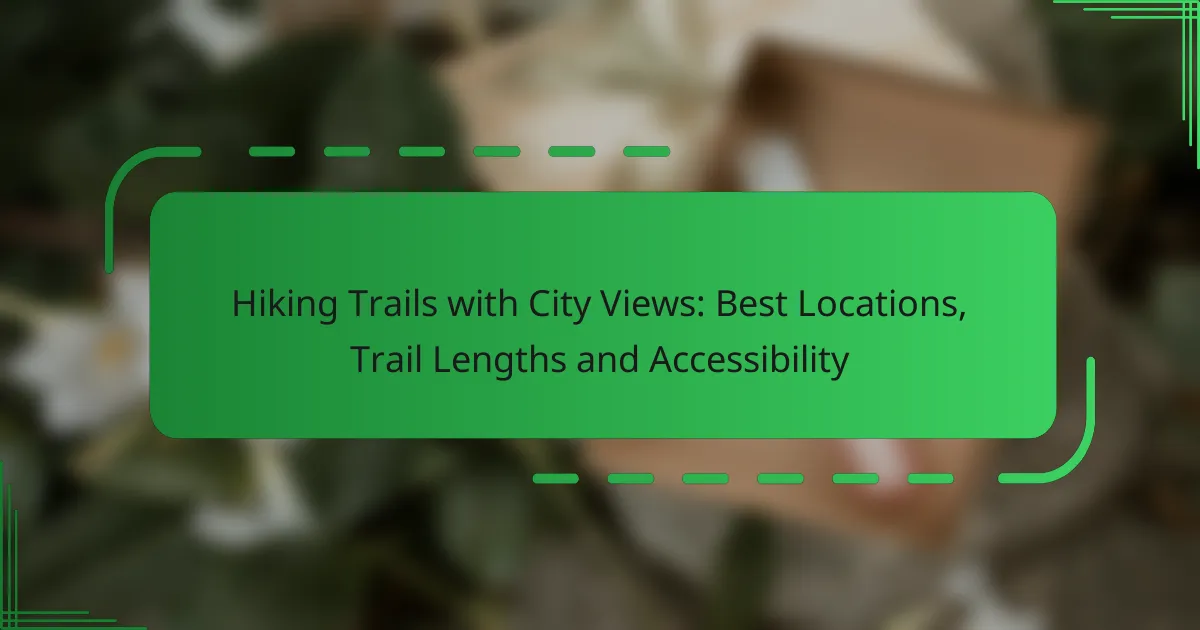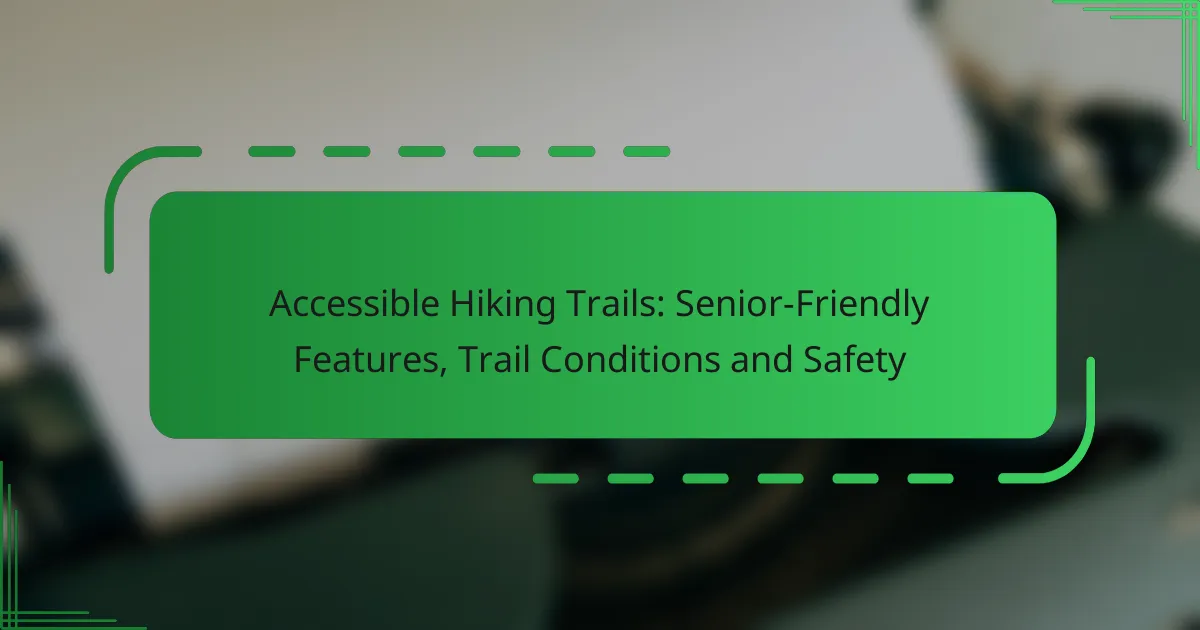Hiking trails with city views offer a perfect blend of nature and urban scenery, allowing outdoor enthusiasts to enjoy breathtaking landscapes while staying close to metropolitan areas. From the iconic Griffith Park Trail in Los Angeles to the picturesque paths in San Francisco and New York City, these trails vary in length and accessibility, making them suitable for hikers of all levels. Whether you’re seeking a quick escape or a more challenging adventure, these locations promise stunning vistas and memorable experiences.
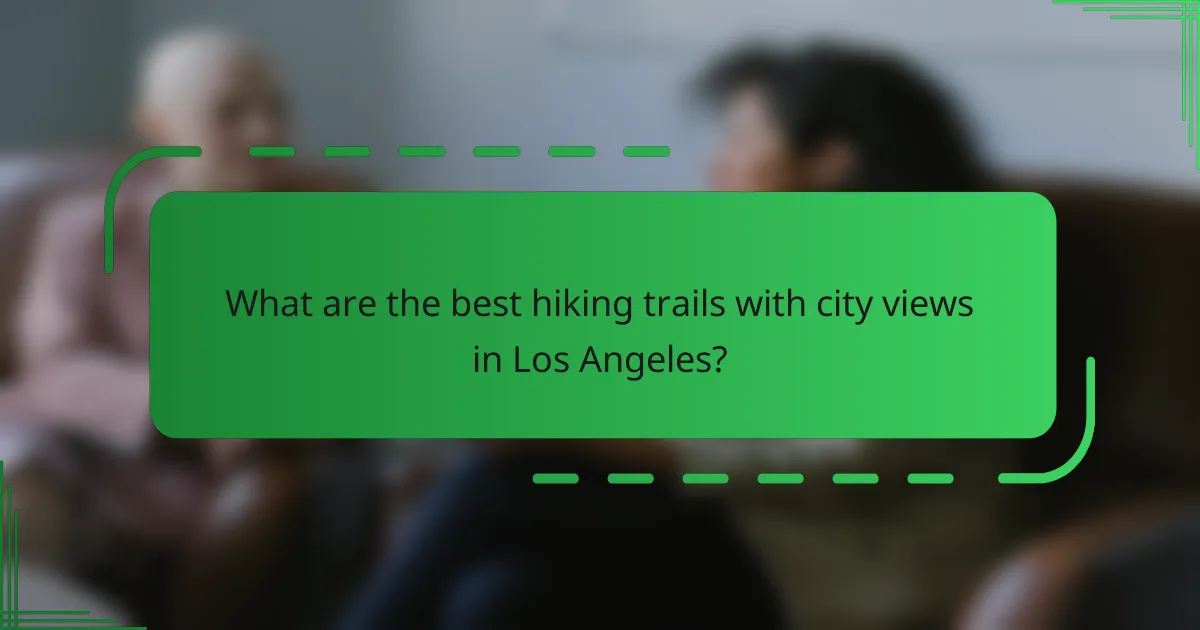
What are the best hiking trails with city views in Los Angeles?
Los Angeles offers several stunning hiking trails that provide breathtaking views of the city skyline and surrounding landscapes. The best options include Griffith Park Trail, Runyon Canyon Trail, and Mount Lee Trail, each with unique features and varying levels of accessibility.
Griffith Park Trail
Griffith Park Trail is one of the most popular hiking spots in Los Angeles, known for its panoramic views of the city and the iconic Hollywood Sign. The trail spans approximately 2 to 3 miles, making it suitable for both casual walkers and experienced hikers.
When hiking this trail, consider starting early in the morning or later in the afternoon to avoid crowds and enjoy cooler temperatures. The trail is well-marked, but be prepared for some steep sections that may require moderate effort.
Runyon Canyon Trail
Runyon Canyon Trail is a favorite among locals and tourists alike, offering a 3-mile loop with stunning vistas of downtown Los Angeles. This trail is known for its accessibility, with multiple entry points and a dog-friendly policy.
While the trail is relatively easy, it can become crowded, especially on weekends. To enhance your experience, visit during weekdays or early mornings. Bring water and wear comfortable shoes, as some areas can be rocky.
Mount Lee Trail
Mount Lee Trail leads to the summit of Mount Lee, where hikers can enjoy spectacular views of the Hollywood Sign and the sprawling city below. The trail is about 1.5 miles long and is considered moderately challenging due to its elevation gain.
For a rewarding experience, plan your hike during sunset for breathtaking views. The trail is less crowded than others, but ensure you have proper footwear and hydration, as it can be steep in sections. Parking is available nearby, but it may require a short walk to the trailhead.

What are the trail lengths of popular city view hikes in San Francisco?
Popular city view hikes in San Francisco vary in length, with options ranging from about 1.5 miles to 3 miles. These trails offer stunning vistas of the city skyline and the Bay, making them accessible for a quick outdoor escape.
Twin Peaks Trail – 3 miles
The Twin Peaks Trail spans approximately 3 miles and is known for its panoramic views of San Francisco. This trail is moderately challenging, with some steep sections that reward hikers with breathtaking sights of the city and the Golden Gate Bridge.
When hiking Twin Peaks, consider starting early in the morning or later in the afternoon to avoid crowds and enjoy cooler temperatures. The trailhead is easily accessible by public transportation, making it convenient for both locals and visitors.
Bernal Heights Park Trail – 1.5 miles
Bernal Heights Park Trail is a shorter option at about 1.5 miles, offering a more leisurely hike with equally impressive views. This trail is relatively easy, making it suitable for families and novice hikers looking to enjoy the outdoors without a strenuous workout.
To make the most of your visit, check out the summit area, which features a grassy knoll perfect for picnicking. Accessible by various public transit routes, Bernal Heights is a great choice for a quick escape from the urban hustle.
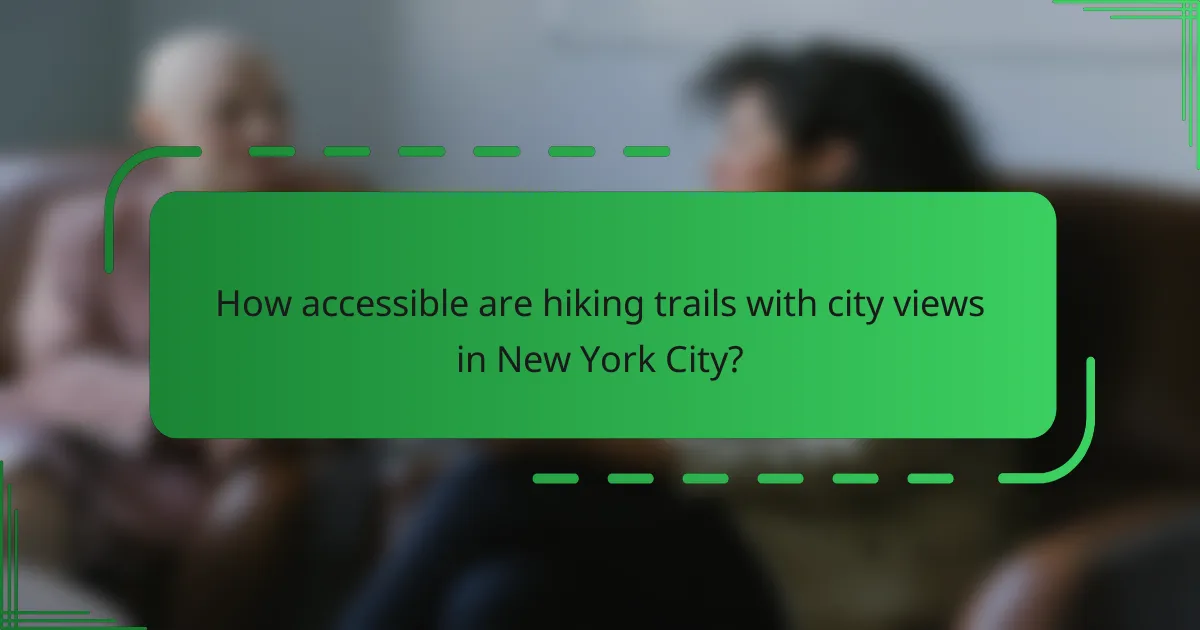
How accessible are hiking trails with city views in New York City?
Hiking trails with city views in New York City vary in accessibility, catering to different needs. Many trails are designed to accommodate families and individuals with mobility challenges, ensuring everyone can enjoy the scenic vistas.
Central Park Loop – wheelchair accessible
The Central Park Loop is a popular choice for those seeking wheelchair-accessible trails. This paved path spans approximately 6 miles, providing a smooth surface ideal for wheelchairs and strollers.
Along the loop, visitors can enjoy stunning views of the city skyline and lush greenery. Amenities such as benches and restrooms are available, making it convenient for longer outings.
Fort Tryon Park Trail – family-friendly
Fort Tryon Park Trail offers a family-friendly hiking experience with accessible paths and playgrounds. The trail is about 1.5 miles long and features gentle slopes, making it suitable for children and strollers.
This park not only provides beautiful views of the Hudson River and the George Washington Bridge but also includes picnic areas and gardens. Families can easily spend a day exploring the park while enjoying the scenery.
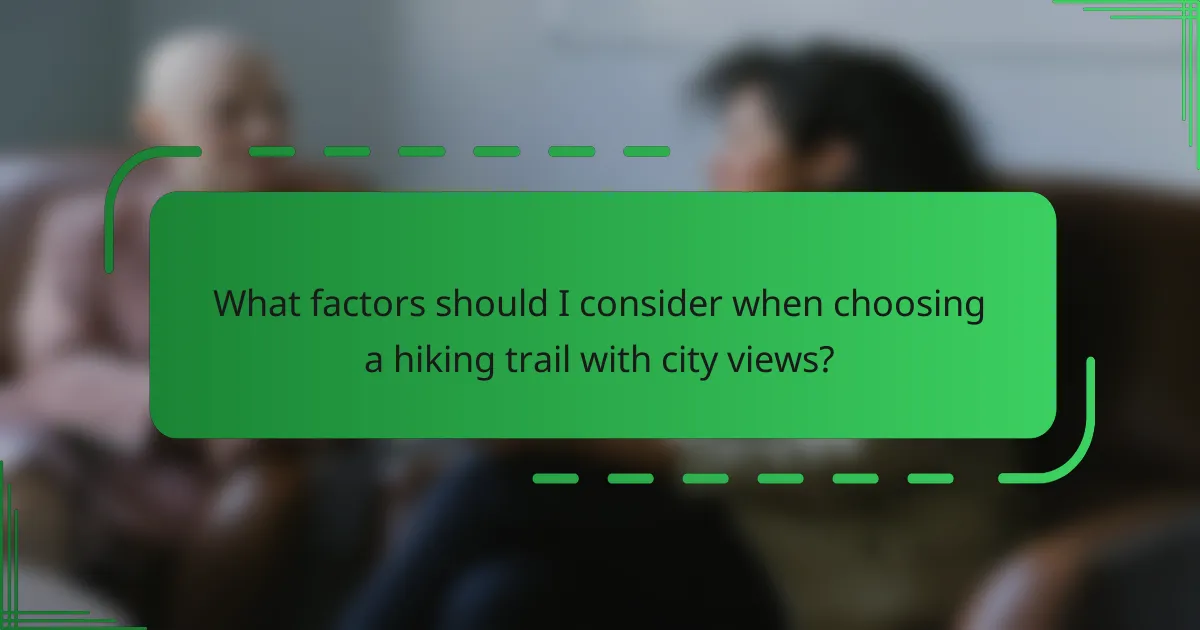
What factors should I consider when choosing a hiking trail with city views?
When selecting a hiking trail that offers city views, consider the trail difficulty level and seasonal weather conditions. These factors will significantly impact your experience, safety, and enjoyment.
Trail difficulty level
Trail difficulty levels can vary widely, typically categorized as easy, moderate, or hard. Easy trails are suitable for beginners and families, often featuring well-maintained paths and gentle inclines. Moderate trails may include some elevation gain and uneven terrain, while hard trails often require advanced skills and physical fitness.
Before choosing a trail, assess your fitness level and experience. For instance, if you are new to hiking, opt for easy trails that provide stunning views without excessive strain. Conversely, if you are an experienced hiker, you may enjoy the challenge of a more difficult route that rewards you with panoramic vistas of the city.
Seasonal weather conditions
Weather can greatly affect your hiking experience, so it’s essential to check seasonal conditions before heading out. In warmer months, trails may be crowded, and temperatures can rise significantly, while winter trails may be icy or snow-covered, requiring special gear.
Consider the best seasons for hiking in your area. For example, spring and fall often provide mild temperatures and beautiful foliage, making them ideal for city view hikes. Always check local forecasts and prepare for sudden weather changes to ensure a safe and enjoyable hike.

What are the best hiking trails with city views in Seattle?
Seattle offers several hiking trails that provide stunning views of the city skyline and surrounding landscapes. Notable trails include Mount Si and Rattlesnake Ledge, each offering unique experiences and varying levels of accessibility.
Mount Si Trail
Mount Si Trail is a popular hike located about 30 miles east of Seattle, known for its challenging ascent and breathtaking panoramic views. The trail spans approximately 8 miles round trip and gains around 3,150 feet in elevation, making it suitable for experienced hikers.
As you hike, expect a steep and rocky path, particularly in the final stretch. The effort is rewarded with a spectacular view of Seattle, the Cascade Mountains, and Mount Rainier from the summit. Be sure to wear sturdy footwear and bring plenty of water, as the trail can be strenuous.
Rattlesnake Ledge Trail
Rattlesnake Ledge Trail is a more accessible option located about 25 miles east of Seattle, ideal for families and casual hikers. This trail is approximately 4 miles round trip with an elevation gain of about 1,200 feet, offering a moderate challenge.
The trail features well-maintained paths and stunning views of Rattlesnake Lake and the surrounding mountains. The ledge at the top provides a perfect spot for a picnic or simply enjoying the scenery. Arrive early to secure parking, as the trailhead can get crowded, especially on weekends.

How do I prepare for hiking trails with city views?
Preparing for hiking trails with city views involves gathering the right gear and understanding the trail layout. Proper preparation ensures a safe and enjoyable experience while maximizing your scenic enjoyment.
Pack essential gear
When hiking trails that offer city views, essential gear includes comfortable footwear, weather-appropriate clothing, and hydration supplies. A sturdy backpack can help carry snacks, a first-aid kit, and navigation tools like a map or GPS device.
Consider packing a camera or smartphone to capture the stunning vistas. Depending on the trail length, you might also want to bring trekking poles for stability and support, especially on uneven terrain.
Check trail maps
Before heading out, review trail maps to understand the route, elevation changes, and estimated hiking times. Many trails provide online resources or apps that offer detailed maps, including points of interest and potential hazards.
Familiarize yourself with the trail’s accessibility features, such as parking availability and public transport options. Knowing the trail’s difficulty level can help you prepare physically and mentally for the hike, ensuring a more enjoyable experience.

What emerging trends are shaping urban hiking experiences?
Urban hiking experiences are increasingly influenced by a focus on sustainability and accessibility. More cities are developing trails that not only provide scenic views but also promote eco-friendly practices and inclusivity for all hikers.
Increased focus on sustainability
Many urban hiking trails are now designed with sustainability in mind, incorporating native plants and minimizing environmental impact. Cities are investing in green spaces that enhance biodiversity and provide natural habitats while offering residents and visitors a chance to connect with nature.
For example, trails may include educational signage about local flora and fauna, encouraging hikers to appreciate and protect their surroundings. This trend not only improves the hiking experience but also fosters a sense of community responsibility towards the environment.
Enhanced accessibility for all hikers
Accessibility is becoming a priority in urban hiking, with many cities implementing features that accommodate individuals with disabilities. This includes paved paths, rest areas, and clear signage to ensure that everyone can enjoy the trails.
Some cities are even offering guided hikes specifically designed for people with mobility challenges, ensuring that urban hiking is inclusive. When planning a hike, consider checking local resources for information on accessible trails and facilities.
Integration of technology
Technology is playing a significant role in enhancing urban hiking experiences. Mobile apps that provide trail maps, real-time weather updates, and safety alerts are becoming commonplace, making it easier for hikers to navigate urban landscapes.
Additionally, augmented reality features in some apps allow hikers to learn about landmarks and natural features along the trail. This integration of technology not only enriches the hiking experience but also promotes safety and awareness of the environment.
